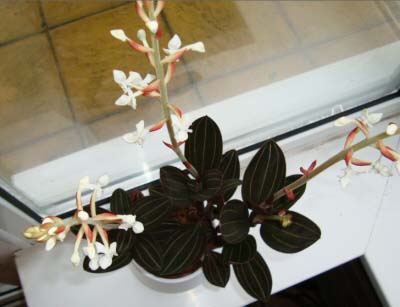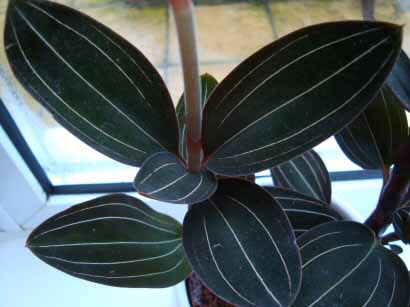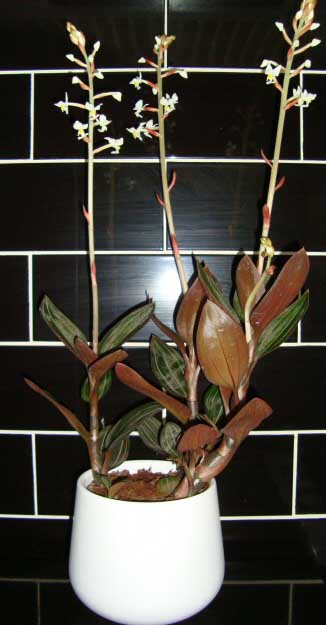





 The Jewel Orchid or Ludisia discolor is unlike all other Orchids we grow in our homes, because it is prized for its foliage rather than its flowers. It's simple and easy to care for and does still produce lovely white little flowers to give it a little more interest than other house plants which are only grown for their foliage.
The Jewel Orchid or Ludisia discolor is unlike all other Orchids we grow in our homes, because it is prized for its foliage rather than its flowers. It's simple and easy to care for and does still produce lovely white little flowers to give it a little more interest than other house plants which are only grown for their foliage.
There is just one type of Ludisia and this has very dark green leaves with fine white pinstripe markings. In certain light the maroon colour underneath the leaves can shine through and turn the white lines a hue of red. Unfortunately the plant itself and the flowers are not showstoppers, so are easily overlooked when compared to its cousins such as the Moth and Cambria Orchids, but it has a contemporary and unusual charm that can appeal to those who chance upon them.  A large Jewel Orchid that is many years old will produce multiple growths and flowering spikes which will certainly create a lasting impression.
A large Jewel Orchid that is many years old will produce multiple growths and flowering spikes which will certainly create a lasting impression.
Bizarrely, unlike its cousins, the Jewel Orchid is really easy to propagate and grow to a saleable size, however sellers often still demand quite a lot of money which could be another reason why Ludisia popularity hasn't really taken off. However if you are keen on a bargain you could be in luck. Its discreet appearance means it's normally only sold when in flower, presumably as this little flourish commands that extra attention to draw the eye. So as the flowers start to go over, or at other times of the year sellers often discount heavily to shift their remaining stock.
Light
Out in it's natural habitat the Jewel Orchid is found growing down low, often in pretty shady places. For the best results try to replicate this in your home or office by avoiding placing it in direct sunlight. North facing rooms are perfect, but any other facing aspect is fine providing you can shield the leaves from any harsh sunlight that filters through during the day. Do not mistake this as a plant which likes darkness though, gloom needs to be avoided as much as direct sunlight.
Damp conditions are what the Jewel Orchid wants and needs to do well
Watering
Slightly damp conditions are what the Jewel Orchid wants for the majority of the time. It does not like to have bone dry or soaking wet soil, leave its roots sitting in water and it will rapidly die. If you are using a more porous potting mix you will need to water more often than if using standard potting soil.
Humidity
If you get the watering requirements (above) perfect, humidity is of only minor importance. If you know you are quite bad when it comes to watering though, give your Jewel Orchid a helping hand by increasing the surrounding humidity. This will give your plant a small buffer to compensate for the care you provide.
They do look lovely and thrive in Bottle Gardens but don't bother if you are keen on making it flower, because the blooms spoil quickly in the very moist environments that Bottle Gardens produce.
Feeding
Jewel Orchids are small feeders, so in reality you will be totally fine if you only fed your plant a few times a year. You can use a special orchid feed or something more generic, it's not overly fussy.
Temperature
If you are too cold or too hot then your Jewel Orchid is probably feeling the same. The lowest temperature that we'd risk is 10°C / 50°F.
Repotting
Repot when the pot is overcrowded or if it starts to become wobbly and top heavy. These orchids tend to spread out rather than grow tall, so their roots do not need a deep pot, a shallow wide pot should be your first choice.
Unlike a lot of orchids you can actually use normal potting compost if you are very careful with the plants watering requirements. Normal potting soil is designed to hold on to water so if you accidentally saturate the soil this saturation stays around for quite a while and drastically increases the possibility of rotting. If you don't feel comfortable or confident with this then the alternative is to use a much more porous soil mix, for example 60% potting soil and 40% grit or perlite etc. A small amount of orchid bark is acceptable in place of grit, but is far too lose to hold much water so you shouldn't use a high amount of bark unless you are happy to water much more frequently.
The actual repotting is easy enough because it's the same method you would use for any other house plant. We've linked to a YouTube Video below that we quite like if you want to see the repotting process visually.
Propagation
The stems are quite brittle and can easily break when you handle the Jewel Orchid so it's common to propagate through stem cuttings when you are repotting the main "cluster". Nothing special is needed, once you have a piece of stem with upper leaves pot it up into a similar potting mix as the parent. New roots should develop within a few months, be careful until this happens as obviously it won't be well anchored into whatever growing media you have chosen.
Speed of Growth
 In Spring and Summer the Jewel Orchid grows rapidly if light levels are decent. In poor light and Winter the growth slows down.
In Spring and Summer the Jewel Orchid grows rapidly if light levels are decent. In poor light and Winter the growth slows down.
Height / Spread
The growth habit of these orchids is to spread rather than grow for height, so often they are wider than they are tall. The flowering stem can double or almost triple the height of the plant.
Flowers
Large flowering spikes shoot out of tops of the plant stems in Autumn / Fall and Winter. Providing good light and correct care has been received during the growing season. Some people cut them off when the buds start to form as they are not considered to better the foliage in terms of appearance. However they are still dainty and pretty, with their small numerous white flowers with yellow centers. If the temperature isn't too warm they should last a few weeks up to a month.
Anything Else?
If you are passionate about the foliage of Ludisia discolor and don't care about the flowers, pinch out the flowering spikes when they start to form. This encourages the plant to remain compact and bushy, producing more leaves whereas allowing the flowering to take place can encourage the plant to become leggy.
Copyright © www.100flowers.win Botanic Garden All Rights Reserved